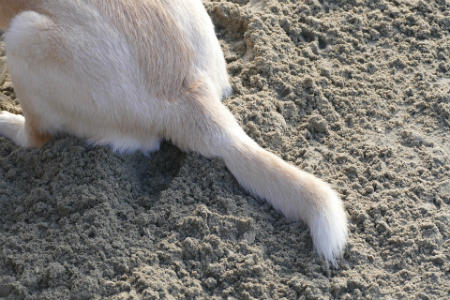The tail of our dog, how do you talk to it?

Meaning of the different positions of the tail
Normally, with the movement of the tail Dogs express excitement And, the greater the movement, the greater the excitement. On the other hand, the nuances that give the movement of the tail depend on the race and size, which are typical of each morphology. In any case, both the movement and the position will indicate the reason for its excitement.
- Fast movements: este comportamiento puede significar una fuerte emoción de ansiedad, felicidad o nerviosismo.
- Circular movements: When your furry friend is stirring the tail in large circles, this type of movements means that it is having fun, whether they are playing with people or other animals. At that time, he does not feel dominant or submissive, he only wants to have fun and is expressing joy and invitation to continue the game.
- Horizontal position: If the dog's tail is in an extended, horizontal but not totally rigid posture, it is transmitting attention.
- Erguided position either Towed tail: In this case, your dog will be expressing dominance and wants to demonstrate its power, security and authority when it is surrounded by other dogs.
- Down tail with movements near the legs: In this case, insecurity and anxiety are manifested by the animal. Even if it tends to move it to the left, it is a sign that it feels threatened.
- Position of the tail above but curved towards the back: It should not be confused with the previous position, since the tail upright and directed slightly towards the back implies a feeling of tranquility and confidence.
- Tail position down and relaxed: It is the most common position of a dog. When it has a low tail but without reaching the legs, the animal is expressing tranquility. It is a sign that it is calm, relaxed and without any concern.
- Position near the legs: When the dog has a low tail but very close to the legs, he is expressing a state of insecurity.
- Tail position between the legs: If the canine is afraid, keeping the tail among the legs is expressing submission. He is stating that he is not the dominant in that situation.
- Tense tail in totally rigid position: If it is extended and horizontally, your hairy friend is trying to intimidate an intruder who is invading its territory. In these cases, he also usually puts on bristily hair. And, if it also tends to move the tail to the left, it means that the dog is analyzing another unknown dog. This position of the tail is part of a knowledge process with another animal. It is part of the rite of the hierarchy between animals of the same species.
- Agitation position: If the dog moves its tail slightly, it is greeting.

Beyond the movement of the tail
Dogs show Another type of behavior with its tail. They not only use it to communicate their emotions, but they play with it. It may be the case that you see your dog chasing its tail. This situation is sometimes normal, especially if they are puppies, since they do it simply when they feel bored. This is a way they use to entertain themselves, and even more, when pets realize that their masters have fun seeing them try to hunt their tail. Then, they do it with the aim of attracting the attention of their owner.

Don't mistreat your dog's tail
As we have mentioned, a dog's tail is one of its most important elements to express their emotions. Therefore, we recommend that, before making a sad and painful mistake for your beloved and faithful friend simply by aesthetics, think that when cutting the tail of a dog you are cutting down the communication capacity and relationship between him and you. If you found this post interesting, you can also read these:Share
